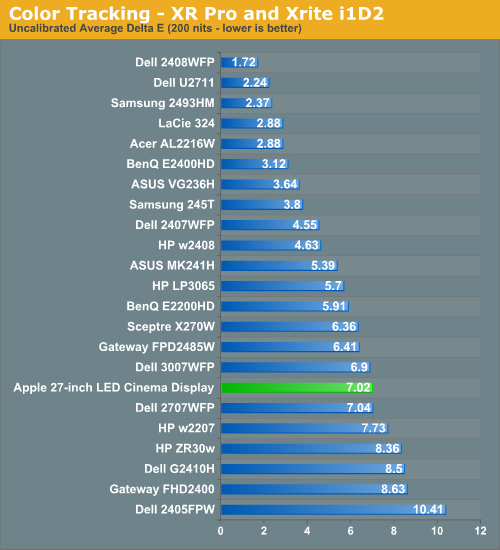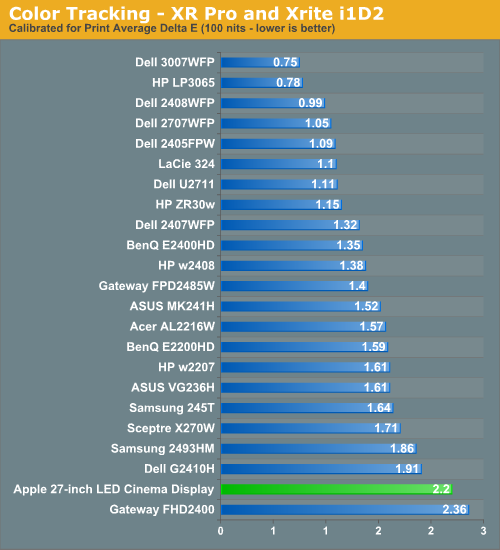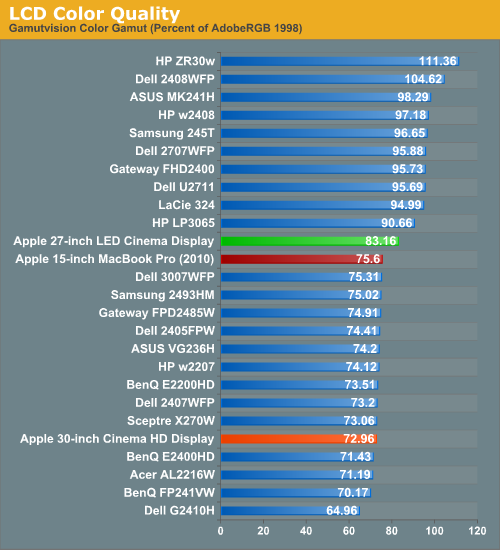Apple 27-inch LED Cinema Display Review
by Anand Lal Shimpi on September 28, 2010 12:15 AM EST- Posted in
- Displays
- Mac
- Apple
- Cinema Display
Color Quality
We report two main quality metrics in our display reviews: color accuracy (Delta-E) and color gamut. Color gamut refers to the range of colors the display is able to represent with respect to some color space. In this case, our reference is the AdobeRGB 1998 color space, which is larger than the sRGB color space. So our percentages are reported with respect to this number, and larger is generally better.
Color accuracy (Delta E) refers to the display’s ability to display the correct color requested by the GPU and OS. The difference between the color represented by the display, and the color requested by the GPU is our Delta-E, and lower is better here. In practice, a Delta E under 1.0 is perfect - the chromatic sensitivity of the human eye is not great enough to distinguish a difference. Moving up, a Delta E of 2.0 or less is generally considered fit for use in a professional imaging environment - it isn’t perfect, but it’s hard to gauge the difference. Finally, Delta E of 4.0 and above is considered visible with the human eye. Of course, the big consideration here is frame of reference; unless you have another monitor or some print samples (color checker card) to compare your display with, you probably won’t notice. That is, until you print or view media on another monitor. Then the difference will no doubt be apparent.
As I mentioned in our earlier reviews, we’ve updated our display test bench. We’ve deprecated the Monaco Optix XR Pro colorimeter in favor of an Xrite i1D2 since there are no longer up-to-date drivers for modern platforms.
For these tests, we calibrate the display and try to obtain the best Delta-E we can get at both 200 nits of brightness for normal use, and 100 nits for print brightness. We target 6500K and a gamma of 2.2, but sometimes the best performance lies at native temperature and another gamma, so we try to find what the absolute best performance could be. We also take an uncalibrated measurement to show performance out of the box using either the manufacturer supplied color profile, or a generic one with no LUT data. For all of these, dynamic contrast is disabled.


Uncalibrated the display's color accuracy isn't very good. I found the 27-inch LED Cinema Display to be way too blue and green out of the box, calibrated the display did much better:


The 27-inch LED Cinema Display isn't going to be winning any awards for color reproduction but it's good enough when calibrated.


Curiously enough, dropping brightness down to 100 nits caused a noticeable reduction in color tracking. The average delta E went up to 2.2 while most of the 27's competitors remained about the same. The 27-inch behaves very differently depending on what brightness setting you have it on.

Apple managed to do relatively well with the WLED backlight but it's still no match for the color gamut you get from any of the CCFL backlit displays. Note that my old 30 hasn't aged well, it's only able to cover roughly 73% today.











93 Comments
View All Comments
chukked - Wednesday, September 29, 2010 - link
very impressive review Anand, Thanks.but this is a cinema display review so response time is of prime concern.
with 12 ms response time i am sure it is having a lot of blurr.
is this the reason you have skipped the response time/ blurr/ ghost tests ?
ijhammo - Wednesday, September 29, 2010 - link
unless I imagined it, wasn't there a screenshot of ghosting?ijhammo - Wednesday, September 29, 2010 - link
i cant find confirmation that the 12ms quoted on the Apple website is GtG time - it just says 12ms (typical)softdrinkviking - Wednesday, September 29, 2010 - link
does anybody know if there is some kind of after market screen coating available to make glass screens a bit anti-glare?you know, something that actually works...
i love the idea of the LED backlighting because they look closer to the brightness of an old CRT to me, and i never felt "shocked" by that amount of brightness. (i find most LCDs to be extremely dim)
so what i'm saying is, i know that there are matte finished alternatives out there (like the 27' Dell that looks nice), but if i want LED backlighting, it doesn't seem like there are any options.
svarog - Wednesday, September 29, 2010 - link
While this review is generally up to the usual high standards I've come to expect from AnandTech, what's up with the lack of a comaprison to the competition in the conclusion? There is a burgeoning market in the 27" high-res monitor space, and from this article it appears that customers would be better served choosing a non-Apple product...?Drag0nFire - Wednesday, September 29, 2010 - link
Looks like the U2711 looks like the better value here. Same IPS 27in goodness, but without the glossy screen, limited input options, and unadjustable stand... and roughly the same price.Seems like this deserves mention in the conclusion?
8steve8 - Wednesday, September 29, 2010 - link
the u2711 costs 10% more, has no webcam, no ambient light sensor, and uses a ccfl backlight which means the display uses almost twice the energy for a given brightness, it's a no brainer to buy the apple.softdrinkviking - Wednesday, September 29, 2010 - link
don't forget that you lose control over the monitor without bootcamp, so it only really works on macs. at least that's what i undstood from this article.8steve8 - Wednesday, September 29, 2010 - link
what is desperately needed is a comparison of power consumption at a given brightness....comparing max brightness power is useless since displays don't all have the same max brightness ,,
a graph of all displays' power usage at 200 nits or whatever would be ideal.
just like performance per watt. we want brightness per watt, or maybe brightness per pixel per watt, or brightness per sqr inch per watt....
at the very least, a calibrated brightness comparison would be appreciated.
thanks.
seapeople - Wednesday, September 29, 2010 - link
I don't generally hop on the "Anand is an Apple fanboi" bandwagon, but articles like this make me wonder. If you look at the data so painstakingly ignored throughout the article, it's obvious that this Apple monitor gets thoroughly trounced by the competition. It doesn't excel at anything (except it's about the third brightest and has the ability to reach brightness levels so low they'd only be usable in the middle of a deep cave) and it gets beat handily in most of the color/contrast ratio measurements. It doesn't even impress much with power consumption -- yes it's the third brightest, but it also uses a lot of power compared to the competition, and the min brightness power consumption doesn't even matter, because how are you going to get an extension cable all the way into the middle of a cave? Of course, if this was a normal PC based product, Anand would give us the relative power consumption at a certain brightness compared to the competition, but then I'm sure doing so wouldn't impress as much as showing how little power this thing draws when it's so dim and shiny that birds would be flying into it if you left the window open.What else have we learned? Well now that Apple has done 16x9, it's cool! Anand actually praised the loss in vertical pixels, with a comment of how he probably didn't use those pixels anyway. See how efficient Apple is! They know exactly what we don't need better than we do. What else don't we need? The ability to use a $1000 monitor with 95% of the computers in the world and be able to adjust the brightness. Not only can't you use this monitor with a Windows computer, but it doesn't work with older Macs unless you get a special adapter. I'm surprised that adapter isn't sold by Apple.
What is there to make up for all these issues? A BUILT IN CHARGER FOR YOUR MACBOOK! OMG!!! Think of all the desk space I save with this 27" monitor now that I don't have to use a separate charger for my macbook. It even gives me 10" to spare, so I don't actually have to physically solder the macbook to the monitor for it to charge. Thank you Apple! It's also convenient that the monitor has no vertical height adjustment, so I don't have to worry about pulling my 10" charger cord off my macbook. Now as long as I don't want to set my macbook on the other side of the monitor...
The proof of the bias in this article is how warm and fuzzy it makes you feel about this product despite the obvious shortcomings. I subconsciously want to buy this monitor now. Anand has done this to me. I logically read and comprehended the data that told me why I shouldn't buy this (especially since I don't have a Mac), but because any direct comparisons to the superior competition were avoided, and the few unique Apple nuances were played up throughout the bulk of the article, I now just have this feeling that this Apple monitor is a great buy. And so do most of the people responding to this article. Thank you Anand. Now I'll probably have to go buy this monitor and hook it up to my PC and be forced to painfully watch my own reflection during Diehard as the monitor sears my eyeballs with its unadjustable atomic blast level brightness. Then I might as well buy a Mac and an Ipad to go along with a brand new Iphone so I can facetime with people I don't even like.